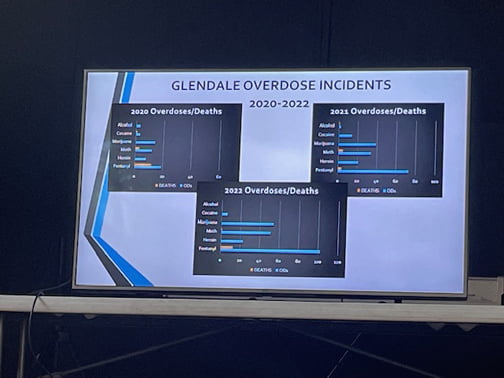
Photo by Mary O’KEEFE
By Mary O’KEEFE
On Tuesday, Narcotics Unit officers from the Glendale Police Dept. spoke to a small audience about the threat of fentanyl in the area, including the Crescenta Valley, and the increased use of vaping by teens.
Sona Hovsepian, clinical program director for Glendale’s Substance Abuse and Wellness Resource Program, led the presentation that was hosted by the Crescenta Valley Substance Misuse Prevention Coalition/CV Cares through the support of the Chace Taylor Malone Impact Foundation LA (IFLA).
“Our work in the community is to connect as many organizations, groups, individuals and family so we collectively can help turn the tide of this crisis and offer as much mental and emotional support for people,” said Victoria Malone, executive director for IFLA and CV Cares. “We know that a lot of the mental well-being is really what opens the door for these other [issues], especially self-medicating.”
“I’ve been with the police department for about 20 years. I have been a police officer for a total of about 23 years. I’ve been on Vice Narcotics … for about eight and a half years,” said Detective Guillermo Jimenez.
He added that once he became a police officer he knew he would gravitate toward narcotics investigation. He had grown up in a house where drugs were around.
“I got to see a lot of things growing up that your normal kid wouldn’t see,” he said.
The officers had drug paraphernalia with them that they had taken from drug-related arrests made in the area. They displayed it on a table.
“[I take] every chance I get to come and talk with the youth and the community,” he said. “My goal is to educate and to possibly save a life.”
Hovsepian asked those in the audience to share what they think of when they hear the word “addiction.” Responses included “isolation” – how people who are addicted to drugs feel isolated and yet have connections with those who can provide those drugs to them, and others who use.
Other descriptions of addiction included “instability” and “chaos.” It was also pointed out that addiction does not just affect the person using the drugs but the family as well.
“[Addiction] is a chronic relapsing disorder characterized by compulsive drug seeking [for the] continued use despite harmful consequences,” said Hovsepian. “The negative consequences can be legal, emotional, physical, relationship, work and school.”
She added that sometimes she hears from addicts that they don’t consider themselves as addicts because they can function at work and school. But when someone ignores the negatives and still must use then “you are on that continuum of addiction.”
“Despite the negative consequences you still want to use. You usually want to use more and more with time. The amount that you’re using is definitely not going to be the amount that you use five years from when you started because you’re not going to get that same high [you got] when you started using,” Hovsepian said.
She shared a video of how drugs affect the brain and why addicts need increased amounts of drugs.
Jimenez shared a 9-1-1 call from a family member of a “troubled teenager” he knew well. He started contacting the teen as he was getting into trouble with vandalism, smoking cigarettes and marijuana possession.
“I was there with him all of my career, and later I found out that he got into harder drugs and then passed away,” Jimenez said.
The young man was using fentanyl daily. He was admitted to the hospital due to an overdose just two days prior to his death. He got help and against recommendation checked himself out of the hospital.
Jimenez and other detectives investigated the overdose death and were able to find someone they thought sold the drugs to the young man. When they accumulated enough evidence they arrested the suspect.
“We recovered … narcotics [including] fentanyl, [methamphetamine], pills and a firearm,” he said.
After interviewing the man suspected of selling the drugs to the young man, Jimenez found he was the victim’s best friend.
He shared this story with those in the audience to let them know these are not strangers but individuals that live, work and go to school in the area.
“[Drug/fentanyl use] is happening more often than you think. It’s impacting a lot of people we as officers deal with, talk to and sometimes have conversations with who are trying to get out [of using drugs],” he added.
Unfortunately, Tuesday’s event was not well attended. After the talk, narcotic officers said this appeared to be normal. They are trying to get the word out about how destructive fentanyl is and how it is in the area – not just in downtown Los Angeles.
It appears most people who are aware of and concerned about this fentanyl crisis are those who have already been touched by the drug. Two people in the audience on Tuesday had lost sons to accidental overdoses of fentanyl, including Malone whose loss of her son Chace inspired IFLA and subsequently CV Cares.
Fentanyl is a synthetic opioid that is up to 50 times stronger than heroin and 100 times stronger than morphine. It is a major contributor to fatal and nonfatal overdoses in California and the United States, according to the California Dept. of Public Health.
There will be two more speaker sessions: Aug. 27 – the speaker will be Dr. Annie Varvaryan, licensed clinical psychologist and co-owner of Couch Conversations in Montrose. The title of her conversation is “Do Your Thoughts Affect Your Life? A Psychologist’s Take on How to Overcome Unhelpful Thoughts.” Then on Sept. 24 Kristen Gilliland, Ph.D. in organic chemistry and a CVHS alumna, will be speaking. The title of her talk is “The Impact of Stress on Substance Use on the Developing Brain.” Both talks will be held at 6 p.m. at St. Luke’s of the Mountains’ Sadler Hall, 2563 Foothill Blvd.
